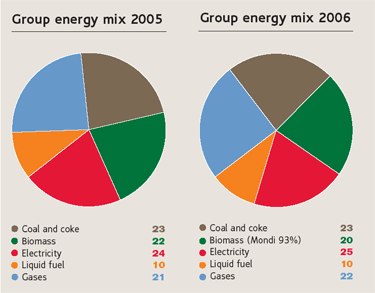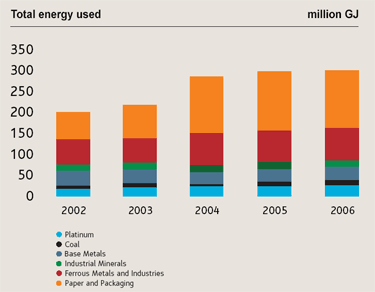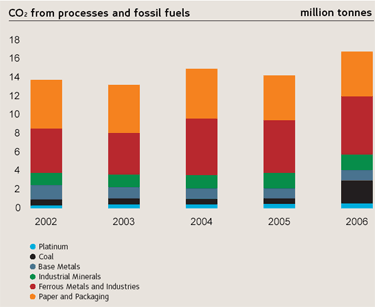|
Since 2003, when a Group-wide energy efficiency training programme and a pilot project were conducted, there has been an increasing focus on efficiency, energy security, the cost of energy and the reduction of carbon emissions.

Total energy use by the
managed companies in the
Group amounted to 304 million
GJ (2005: 298 million GJ),
including 58 million GJ of
biomass – due to increased
production. Excluding Mondi, the
Group used 168 million GJ.
With the implementation of the
Group strategy which will see
significant energy users leave
the Group in the first half of
2007, the energy usage and
energy mix is likely to change
significantly in the future. (see Data
tables.)
Two energy days were held to
share experiences and focus
the Group on carbon mitigation,
efficiency and successful energy
reduction interventions by
suppliers. Key recommendations
summarised by our chairman,
Sir Mark Moody-Stuart, included
the need for Group-wide
reviews of electrical energy
supply and security and an
increased need to make capital
available for energy-efficiency
projects.
Interaction with other leading
companies on their experience
of energy management has
provided valuable insight
into how to speed up the
energy efficiency improvement
programme.
Internally, focus groups work
closely with the procurement,
engineering and mining
functions to ensure the
integration of energy efficiency
into daily business.
Group companies reaffirmed
their commitment to the
voluntary South African
Energy Accord when the new
Minister of Minerals and Energy
was appointed. This accord
formally commits South African
operations to a 15% energy
saving against a business-as-
usual baseline. Anglo American
has a similar target for 2014.
The measurement of energy
efficiency to a common
standard is proving to be a
challenge in a changing and
evolving organisation. Project
management software to
monitor and focus this process
will be tested.
The South African electricity
industry is straining under the
burden of increasing growth in
demand, a lack of significant
recent investment in capacity
and problems resulting from the
restructuring of the electrical
distribution system.
The Group is monitoring the
associated risks including
those related to the installation
of new and rebuilt power
stations in South Africa and the
shortage of reserve capacity.
The availability of skills to
support energy generation and
the shortage of generator-set
manufacturing capability are
concerns. Anglo American’s
South African companies are
significant players in national
electricity supplier Eskom’s
Demand Side Management
programme. Current proposals
submitted to Eskom amounted
to R345 million ($51 million) in
savings at year end. In addition,
the Group has benefited from
participation in the demand
market through which unused
energy contractually supplied
to Namakwa Sands, the
Rustenburg platinum smelters,
Highveld Steel and Mondi
Richards Bay is offered back to
the electricity market at peak
rates during crisis periods.
Climate change
In 2006, the Group generated
greenhouse gas (GHG)
emissions of 36 million tonnes
of direct and indirect CO2
equivalents (CO2e), including
3 million tonnes of CO2e from
coal mine methane (30 million
tonnes excluding Mondi). This
represents an increase of 11%
on the 32 million tonnes of
GHG emissions generated
in 2005, of which 1.25% is
attributed to a change in the
factor for CO2 from electricity
purchased in South Africa.
CO2 emissions from
spontaneous combustion and
the use of explosives by Anglo
Coal South Africa were reported
for the first time.


Anglo Coal has begun engaging
more directly with customers
who use the thermal coal
for power generation (89%
of total sales) to promote
a better understanding of
sustainable development,
clean coal technology and
CO2 mitigation. During 2007,
Anglo Coal will initiate work to
quantify lifecycle CO2 emissions
associated with its coal
production.
A 2003 assessment of our
likely direct financial exposure
from climate change policy
indicated only minor potential
impacts from compliance
requirements and moderate
potential impacts on product
sales in the period to 2012 as
our operations in developing
countries do not have
emissions-reduction targets.
As part of our commitment
to work responsibly wherever
we operate, all investment
proposals are required to
factor in a cost of carbon to
raise awareness and support
efforts to reduce emissions. We
recognise the risk that current
policies on carbon emissions
may increase the cost of
energy.
During 2006, our strategic
focus was on identifying and
developing carbon abatement
opportunities. The Monash
Energy clean coal-to-liquids
project in the state of Victoria,
Australia, is the first in a clean
coal energy alliance formed by
Anglo American and Shell in
May 2006.
In the initial concept phase,
which is expected to conclude
during 2007, Monash
Energy in conjunction with
technical advisers from the
two investors will carry out a
study of the commercial and
technical aspects, including
carbon capture and storage. If
successful, this study will form
the basis for the feasibility
phase and demonstration
activities.
The Monash Energy project
will involve the gasification
of Anglo American’s brown
coal from Victoria’s Latrobe
valley for further conversion
into clean transportation fuels,
principally ultra low sulphur
synthetic diesel. The process
will use Shell’s proprietary
gas-to-liquids technology. A
number of locations under the
Bass Strait, between Australia
and Tasmania, have been
identified as potential sites for
the storage of CO2 from the
process.
Should the feasibility of
the project be proved and
we continue with Shell to
construct the plant, a highly
significant step would be
taken to demonstrate the
commercial viability of
synthetic fuel processes with
geological storage of CO2.
Our project could also play
an important role in providing
the infrastructure for other
industrial processors in South
Victoria to transport their CO2
to long-term storage sites.
Two coal mine methane
abatement projects in
Queensland, Australia, were
commissioned. These will
reduce our GHG emissions by
as much as 2 million tonnes of
CO2e over 12 months.
A number of important
relationships are developing
with other stakeholders in order
to help make a reality of clean
coal technologies. These can
be classified as those related to
industry bodies, those that are
project or technology focused
and those that are political.
In 2006, we signed up as
members of the FutureGen
Alliance led by the US
Department of Energy. This
aims to produce coal-fired power
with near-zero emissions of
sulphur, nitrogen, particulates
and carbon, but at a cost no
greater than 10% above the
cost of conventional coal-fired
power generation.
Click to view a larger version
The alliance includes 12
international coal mining and
power generating companies
and is likely to constitute the
most advanced clean coal
power generation project under
development.
Mining is vulnerable to the
effects of climate change.
Extreme weather events and
changing patterns in water
distribution leading to floods
or prolonged droughts and
water shortages could be of
great significance. Mining and
ore processing operations are
large users of water, although
it is possible to reduce these
volumes (see also water use).
We are considering an
investigation, based on
meteorological models, of
the possible physical impacts
of climate change on our
operations. If commissioned,
we would use the results of
this assessment to judge the
degree to which our operations
might be affected and to
consider changes in the design
and layout of our mines and
facilities to minimise
possible disruption.
We published our Climate
Change Policy in 2002 and
have used it to guide our
actions to date. All policies will
be reviewed during 2007.
| |
Rail |
Road |
Ship |
Air |
Total |
| Anglo |
|
|
|
|
|
| American plc |
|
|
|
|
|
| Totals |
777,000 |
313,000 |
3,301,000 |
2,000 |
4,400,000 |
| Click here for a more detailed look at the data tables |
The likelihood of operating in a
carbon-constrained future has
been built into our strategic
thinking. A post-2012 Climate
Change Policy Scenarios
exercise was conducted in June
2006 with inputs from a range
of international experts. The
scenarios have helped inform
our business decisions.
At the heart of our strategic
considerations has been the
investigation of ways in which
the widespread use of coal
in the future can be made
compatible with sustainable
development.
We recognise that climate
change will be a reality for the
rest of this century and beyond,
despite our ability to advance
the mitigation of future
emissions from our operations
and those that arise from the
use of our products.
In 2004, we committed to
estimate the emissions that
arise from air travel and the
transportation of our products
by land, sea and air to final
customers. This proved
challenging and a number of
assumptions had to be made:
- road transport data were
sometimes available only
as kilometre totals. The
average truck loading was
assumed to be 20 tonnes
- generic emissions factors,
obtained from the
Greenhouse Gas Proctocol
developed by the World
Resources Institute and
the WBCSD, were used as
we do not have detailed
information on vehicle
types and sizes used by
contractors
- return journeys were not
included
- approximations were
made for the location of
customers and at what
point our responsibility for
emissions ended
- the boundary issue
requires further work
- emissions from air travel
in 2005 were estimated
at about 13,000 tonnes
of CO2 – based on 102
million longhaul kilometres
and 13.7 million mediumhaul
kilometres flown
between London and
Johannesburg.
Given the assumptions and, in
some instances, best guesses
made in producing these
estimates, the results must be
taken as indicative only. KPMG
reviewed the methodology and
we are confident that the final
figures identify those products
and modes of transport
where our emissions are most
material.
Unsurprisingly, in view of
its bulk and the distances
travelled, more than 80% of
these emissions arise from the
transport of coal.
We are active in the debate
about energy at industry,
project and political level.
Critical engagement takes
place through the World Coal
Institute, the International
Energy Agency’s Coal Industry
Advisory Board and Clean
Coal Centre, as well as
organisations in South Africa
and Australia.
Project-focused engagement
has been through the
Australian CO2 Co-operative
Research Centre (CO2CRC),
the Carbon Sequestration
Leadership Forum, the
International Emissions Trading
Association, the South African
National Energy Research
Institute and Coaltech 2020
in South Africa.
At a political level, this has
involved South African,
Australian and EU energy and
environment ministries and
the Globe Legislators for a
Balanced Environment.
Group companies have a
number of projects nearing
completion of CDM project
registration and the Group is
positioning itself to increase
involvement in this area
now that the processes are
becoming more transparent.
Long-term progress in this area
is premised on a continuation
of some form of Kyoto
Protocol-style mechanisms
beyond 2012.
In August, the methodologies
used by Highveld Steel’s
Transalloys energy efficiency
project (estimated reduction
of 98 kilotonnes of CO2e) and
Mondi Richards Bay’s biomass
fuel switch project (estimated
reduction of 122 kilotonnes of
CO2e) were approved by the
CDM executive board, which
represents a critical stage on
the road to obtaining project
registration.
In South Africa, we have also
identified potential projects
in the Waterberg area and at
New Denmark colliery (coal
mine methane), Scaw Metals
(fuel switch from producer
gas to natural gas) and at a
number of our platinum mines
(substitution of electric for
pneumatic rock drills).
Following a local energy supply
crisis during which energy
users were required to restrict
peak usage, Namakwa Sands
conducted a comprehensive
energy audit.
The continuous production
process and customer
obligations meant that periodic
switch-off was impossible for
Namakwa Sands. However, the
operation found ways to reduce
demand quickly by cutting its
non-essential use of electricity.
This included switching off
office lights, air conditioning,
plant lighting and motors
running unnecessarily during
peak periods.
High-energy consumption
pumps were used only during
off-peak hours. A substantial
saving was also achieved at the
smelter by using only one
ladle heater during off-peak
periods. The total energy
reduction of 2.5 megawatt
hours per day translated into a
financial saving of R4.5 million
($665,000).
The success of the project
has prompted a closer look at
all power usage and further
initiatives are planned, including
focusing on the need to save
energy to prevent outages and
as a way of tackling climate
change. Large power-usage
information display boards are
being erected at the plants
to increase awareness and
encourage further savings.
Anglo Coal Australia is
exploring alternative renewable
fuels for use in on-site
machinery and equipment.
A biodiesel blend has been
put to the test at Callide mine
since June 2006 as part of an
Anglo American management
development programme project
on alternative fuel solutions.
Preliminary results showed no
significant reduction in power
output or increase in the fuel
burn rate of the machinery.
Additional equipment will be
tested. Work is continuing on
the estimations but external
studies report greenhouse gas
emission reductions of 16%
when using a 20% biodiesel
blend.
If the tests are successful,
Anglo Coal Australia will
explore the potential for a local
biodiesel plant run on methane
gas for its opencast operations.
Upstream and downstream
benefits are anticipated,
including reduced greenhouse
gas emissions, reduced
transport emissions, local
job opportunities and the
supply of surplus biodiesel to
neighbouring communities and
mine sites.
Anglo Coal Australia hosted an
evening to show the Oscarwinning
documentary about
climate change, An Inconvenient
Truth, to customers, suppliers,
government departments and
mining industry representatives
including John Wallington, chief
executive officer of Anglo Coal
and Anglo American’s head of
energy, Roger Wicks.
Rachel Mitchell, environmental
advisor at Anglo Coal’s
Moranbah North site in
Australia, was selected by
Al Gore’s Climate Project to
spread the word about climate
change. She is one of
75 Australians trained to
deliver this presentation on
climate change.
The Australian Conservation
Foundation will support the
training programme, working
closely with Climate Project
staff in the US. Mitchell will
now take the presentation
to local communities around
Moranbah and central
Queensland.
Anglo Coal Australia’s Capcoal power plant at German Creek mine, is one of Queensland’s first electricity generators to be fuelled by coal seam methane.
Anglo Platinum is installing
an automatic system that
will optimise the use of air
compressors to reduce energy
consumption and cut costs at
its South African mines.
Compressed air is a
major source of energy in
underground mines. It is used
to power drills, pumps and
other mechanical equipment.
Up to 15 megawatts of power
is needed to drive compressors.
The new system will ensure
the optimum number of
compressors is in use at any
one time. Off-peak electricity
will be used where possible.
Savings of up to 75,978 GJ
and R3.2 million ($0.5 million)
could be achieved.
The system will be working at
Anglo Platinum’s Rustenburg
mine in early 2007, and is
being installed at Amandelbult
and Lebowa mines.
As a contribution towards
combating climate change,
Anglo American Chile has set
a target of decreasing CO2
emissions by 10% by 2008
(against a business-as-usual
baseline) as well as reducing
energy and fresh water
consumption. The 2014 goal is
15% saving in energy use.
Anglo American Chile also
has an initiative to introduce
modified hybrid vehicles
into its fleet. These vehicles
have significantly lower fuel
consumption and generate half
the emissions of conventional
vehicles. This agreement also
makes provision for cheaper
finance to employees through
salary advances, thereby
encouraging the purchase of
hybrid technology vehicles and
reduction of the energy use
and CO2 emission profiles of
employees.
An energy committee has
defined a 2003-2013 energy
consumption and emissions
framework and a campaign to
promote responsible energy
usage by all employees, at work
and at home.
A standardised measurement
methodology, which uses
specific control indicators to
enable comparison against a
business-as-usual baseline, was
established. This is necessary
due to changes in the operations
where new projects might mask
energy efficiencies that have
already been achieved.
The methodology enables
the determination of certified
reductions, potential reductions
and required reductions, which
are internally certified. Potential
reductions are the reduction
opportunities still to be
implemented, while the others
are required to achieve the
targets that have been set.
Anglo American Chile is
also working with Chile’s
country-wide energy
efficiency programme to
share experiences. More than
2,400 leaflets in support of
the campaign were distributed
to the company’s employees
and a further 600 to the
communities around the five
operations.
In Victoria, Australia, Monash energy engineers (Matt Pietsch and Greg Eagle) examining cored material.
|